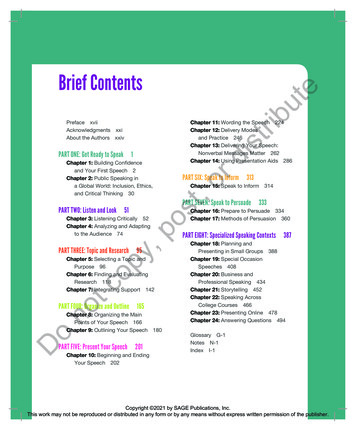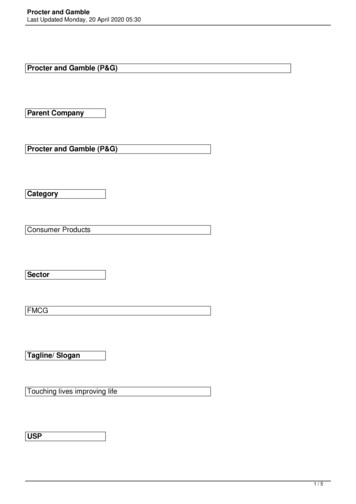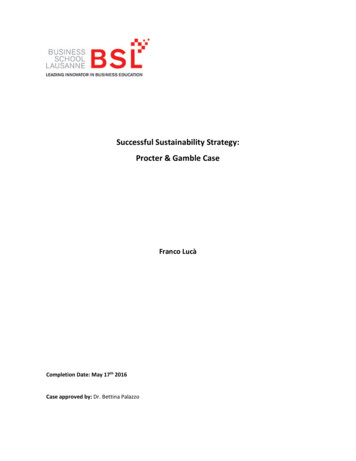
Transcription
ributeBrief ContentsChapter 11: Wording the Speech 224Chapter 12: Delivery Modesand Practice 246Chapter 13: Delivering Your Speech:Nonverbal Messages Matter 262Chapter 14: Using Presentation Aids 2861t,ordPART ONE: Get Ready to SpeakistPreface xviiAcknowledgments xxiAbout the Authors xxivChapter 1: Building Confidenceand Your First Speech 2Chapter 2: Public Speaking ina Global World: Inclusion, Ethics,and Critical Thinking 3051PART SEVEN: Speak to Persuadecopy,PART EIGHT: Specialized Speaking Contexts95notChapter 5: Selecting a Topic andPurpose 96Chapter 6: Finding and EvaluatingResearch 118Chapter 7: Integrating Support 142PART FOUR: Organize and Outline165DoChapter 8: Organizing the MainPoints of Your Speech 166Chapter 9: Outlining Your SpeechPART FIVE: Present Your Speech201Chapter 10: Beginning and EndingYour Speech 202333Chapter 16: Prepare to Persuade 334Chapter 17: Methods of Persuasion 360Chapter 3: Listening Critically 52Chapter 4: Analyzing and Adaptingto the Audience 74PART THREE: Topic and Research313Chapter 15: Speak to Inform 314posPART TWO: Listen and LookPART SIX: Speak to Inform180387Chapter 18: Planning andPresenting in Small Groups 388Chapter 19: Special OccasionSpeeches 408Chapter 20: Business andProfessional Speaking 434Chapter 21: Storytelling 452Chapter 22: Speaking AcrossCollege Courses 466Chapter 23: Presenting Online 478Chapter 24: Answering Questions 494Glossary G-1Notes N-1Index I-1vCopyright 2021 by SAGE Publications, Inc.This work may not be reproduced or distributed in any form or by any means without express written permission of the publisher.
ributeDetailed ContentsExercises24Recap and Review28t,ord1Key Terms28AP Photo/Frank Franklin IILeontura/Getty ImagesPART ONE: Get Ready to Speakist1.4c Practice Delivery 211.4d Conduct a Post-PresentationAnalysis 22Preface xviiAcknowledgments xxiAbout the Authors xxivposChapter 1: Building Confidence andYour First Speech 24copy,Section 1.1 IdentifySpeechmaking’s Benefits 41.1a Benefits for Your Personal Life1.1b Benefits for Your Career 41.1c Benefits for Society 5Chapter 2: Public Speaking in a GlobalWorld: Inclusion, Ethics, and CriticalThinking 30Section 1.2 Discuss the Context ofPublic Speaking 61.2a Picture the Parts Working Together 71.2b Consider Audience Expectations 8DonotSection 1.3 Assess and Build YourSpeechmaking Confidence 101.3a Understand Public Speaking Anxiety 111.3b Address the Physical Effects ofSpeech Anxiety 121.3c Address the Mental Effects ofSpeech Anxiety 131.3d Use Skills Training 141.3e Anxiety Can Be Transformative 14Section 1.4 Approach Giving aSpeech Systematically 161.4a Select Your Topic 161.4b Develop, Support, and OrganizeYour Speech 18Section 2.1 Respect DifferentCultures 322.1a Attune Yourself toDifference 332.1b Assess Your Understanding ofCultural Diversity 342.1c Reflect Cultural Values 342.1d Understand CulturalIdentity 362.1e Consider Preferred LearningStyles 382.1f Understand Difference to BuildBridges and Confidence 38Section 2.2 Speak Ethically 392.2a What Audiences Expect ofSpeakers 402.2b What Speakers Expect ofAudiences 44Section 2.3 Think Critically 452.3a Set Goals 452.3b Analyze Consequences 46Copyright 2021 by SAGE Publications, Inc.This work may not be reproduced or distributed in any form or by any means without express written permission of the publisher.
Recap and ReviewKey Terms5050PART TWO: Listen and Look515270Recap and ReviewKey Terms7373posSection 3.2 Listening andCultural Differences 58Exercisesnotcopy,Section 3.3 The Benefits ofCritical Listening 593.3a Reduced Stress 593.3b More Learning 593.3c Improved Speaker–AudienceRelationship 593.3d Improved Decision Making 593.3e Improved Speaking 603.3f A Better Society 60DoSection 3.4 The Four Types of Listening 613.4a Type 1: Appreciative: Listeningfor Pleasure 613.4b Type 2: Empathic: Listening toProvide Emotional Support 613.4c Type 3: Comprehensive:Listening to Get Information 613.4d Type 4: Critical/Deliberative:Listening to Make an Evaluation 62Section 3.5 Listening Styles 633.5a People-Oriented Listening 633.5b Action-Oriented Listening 63Leave room for credit line.Section 3.1 The Six Stagesof Listening 553.1a Stage 1: Hearing 553.1b Stage 2: Understanding 553.1c Stage 3: Remembering 563.1d Stage 4: Interpreting 563.1e Stage 5: Evaluating 563.1f Stage 6: Responding 57t,ordDaniel Koebe/Corbis/VCG/Getty ImagesChapter 3: Listening CriticallySection 3.6 Improving ListeningBehaviors 643.6a Stay Tuned In 653.6b React Honestly 653.6c Give a Fair Hearing 653.6d Control EmotionalReactions 663.6e Challenge Yourself 673.6f Focus on the Value in theSpeech 673.6g Control the PhysicalEnvironment 683.6h Use Time Wisely 69e48ributExercises3.5c Content-OrientedListening 633.5d Time-Oriented Listening 63ist2.3c Assess Outcomes andTheir Effects 47Chapter 4: Analyzing and Adaptingto the Audience 74Section 4.1 Reach Out to YourAudience 764.1a Consider the Audience’sMakeup—Explore andCelebrate Its Diversity 764.1b Be Audience Centered—UseEmpathy 76Section 4.2 Answer PreliminaryQuestions 78Section 4.3 Compose aDemographic Snapshot 794.3a Consider Age 794.3b Consider Gender 804.3c Respect AffectionalOrientation 814.3d Gauge Knowledge Level 814.3e Understand Racial, Ethnic,Religious, and Cultural Ties 81Copyright 2021 by SAGE Publications, Inc.This work may not be reproduced or distributed in any form or by any means without express written permission of the publisher.
5.2b Formulate the SpecificPurpose 1055.2c Consider the Audience’sPerspective 10782Section 4.4 Compose aPsychographic Snapshot 834.4a Understand Values, Beliefs,and Attitudes 834.4b Understand How the AudiencePerceives Your Topic 844.4c Understand How the AudiencePerceives You 84Exercises92Recap and Review9393copy,Key Terms95notBremecR/Getty ImagesPART THREE: Topic and ResearchChapter 5: Selecting a Topic andPurpose 96Section 5.1 Formulate a Topic 985.1a Use BrainstormingTechniques 985.1b Use Other Topic SelectionTechniques 102Doeribut111116t,ordRecap and ReviewKey Terms116posSection 4.6 Get Information AboutYour Audience 874.6a Ask Your Contacts 874.6b Use Personal Knowledge andObservations 884.6c Research Audience Attitudes 88ExercisesAlex Segre/Alamy StockPhotoSection 4.5 Consider theSpeaking Situation 854.5a Analyze the Occasion 854.5b Consider the Location 854.5c Consider the Time 864.5d Gauge Audience Size 86Section 5.3 Formulate the ThesisStatement or Central Idea 1095.3a Thesis Statements forInformative Speeches 1095.3b Thesis Statements forPersuasive Speeches 1095.3c Evaluating the ThesisStatement or Central Idea 110ist4.3f Identify Affiliations 824.3g Consider SocioeconomicsSection 5.2 Formulate General andSpecific Purposes 1045.2a Formulate the GeneralPurpose 104Chapter 6: Finding and EvaluatingResearch 118Section 6.1 Use Primary Research 1206.1a Use Personal Knowledge andExperience 1206.1b Interview Others WithSpecialized Knowledge 120Section 6.2 Gather SecondaryResearch 1256.2a Library Resources 1256.2b Online Sources—AskQuestions 1276.2c Websites—ConsiderTrustworthiness 1286.2d Blogs—Be Cautious 1296.2e Wikis—Be Wary 129Section 6.3 Why to CriticallyAssess Research 1306.3a Assess TraditionalResearch Sources 1306.3b Evaluate Online Sources 130Section 6.4 Keep a ResearchRecord 132Copyright 2021 by SAGE Publications, Inc.This work may not be reproduced or distributed in any form or by any means without express written permission of the publisher.
6.4a Take Good Notes 1326.4b Cite Source MaterialsCarefully 134Dan Reynolds Photography/ Getty Images142Exercises163Recap and ReviewKey Terms164164posChapter 8: Organizing the MainPoints of Your Speech149copy,Section 7.3 Use Definitions 1507.3a Which Words Should YouDefine? 1507.3b How Do You Define a Word?7.3c Assess the Power of YourDefinitions 151165AP Photo/Seth Wenigt,ordPART FOUR: Organize and OutlineSection 7.1 Use Examples 1447.1a Short Examples 1447.1b Narrative Examples 1447.1c Hypothetical Examples 1457.1d Assess the Power of YourExamples 146Section 7.2 Use Explanationsand Descriptions 1487.2a Explanations 1487.2b Descriptions 1487.2c Assess the Power of YourExplanations and DescriptionsSection 7.7 Citing Sources inYour Speech 161ribut141e7.6c Assess the Power of YourTestimony 160141Chapter 7: Integrating Support151notSection 7.4 Use Analogies 1527.4a Literal Analogies 1527.4b Figurative Analogies 1527.4c Assess the Power of YourAnalogies 153Do1591597.6b Peer or Lay Testimony 159138Recap and ReviewKey Terms7.6a Expert TestimonyistExercisesSection 7.6 Use TestimonySection 7.5 Use Statistics 1547.5a Understand WhatStatistics Mean 1547.5b Put Statistics to Use 1557.5c Use Statistics Ethically 1557.5d Present Statistics Visually 1567.5e Assess Your Use of Statistics 156166Section 8.1 Understand SpeechPatterns: Organization 168Section 8.2 Use Linear OrganizationalFormats to Arrange a Speech’s MainPoints 1698.2a Time Order: It’s Chronological8.2b Spatial Order: It’s Directional1691718.2c Cause-and-Effect Order: It’sRelational 1728.2d Problem–Solution Order: It’sWorkable 1738.2e Topical Order: It’s Part of theWhole 174Section 8.3 Use Less DirectConfigural Formats 175Exercises178Recap and ReviewKey Terms179179Copyright 2021 by SAGE Publications, Inc.This work may not be reproduced or distributed in any form or by any means without express written permission of the publisher.
Hiraman / iStock10.1d Quote a Relevant Source10.1e Use Humor 20810.1f Arouse Emotion 209Section 9.2 Facilitate Speech Flow 1899.2a Use Transitions 1899.2b Use Internal Previews 1909.2c Use Internal Summaries 1919.2d Use Signposts 191Key Terms199199Chapter 10: Beginning and EndingYour Speech 202DoeistSection 10.4 End Strong 21510.4a Keep It Short 21610.4b Forecast the Finish Line 21610.4c Restate the Thesis orCentral Idea 21710.4d Motivate the Audience(Again) 21710.4e Achieve Closure 218Section 10.5 Avoid Common PitfallsExercises221Recap and ReviewKey Terms219223223201notChip Bayer/AlamyStock PhotoPART FIVE: Present Your Speech214sjenner13/iStockcopy,198Recap and ReviewSection 10.3 Preview the Big IdeasposSection 9.3 Practice Speaking WithYour Outline 1969.3a Prepare Your Extemporaneousor Presentation Outline, AlsoKnown as Speaker’s Notes 197ribut180Section 9.1 Create an Outline ThatWorks for You 1829.1a Identify Your Main Points 1839.1b Support Main Points WithSubordinate Points 1859.1c Use Coordinate Points 1879.1d Exhibit Parallelism 1879.1e Label All Parts 188ExercisesSection 10.2 Build Credibility 21010.2a See Yourself ThroughTheir Eyes 21010.2b Demonstrate Your Credibility 21110.2c Establish Topic Credibility andRelevance 21210.2d Connect Credibility andCulture 212t,ordChapter 9: Outlining Your Speech207Section 10.1 Capture Attention 20410.1a Startle or Shock theAudience 20610.1b Involve the Audience 20710.1c Arouse Curiosity and BuildSuspense 207Chapter 11: Wording the Speech224Section 11.1 Understand HowWords Work 226Section 11.2 Use Wordsto Connect 227Section 11.3 Consider YourAudience 22811.3a Overcome CommunicationObstacles 22811.3b Consider Time and Place 22911.3c Observe Reasoning andThinking Preferences 22911.3d Use Plain, UnbiasedLanguage 231Copyright 2021 by SAGE Publications, Inc.This work may not be reproduced or distributed in any form or by any means without express written permission of the publisher.
261236e241243Recap and ReviewKey TermsKey Terms261244244Section 13.2 Take Control of HowYou Sound 265Section 13.3 Properly Use Pitch, Volume,Rate, Articulation, and Pronunciation 26713.3a Vary Pitch 26713.3b Adapt Volume to the Situationand Cultural Norms 26813.3c Adjust Rate, Use SilentPauses, Avoid Fillers 26913.3d Attend to Articulation andPronunciation 271copy,posSection 12.1 Choose a Delivery Mode 24812.1a Impromptu Speaking 24912.1b Manuscript Reading 25012.1c Extemporaneous Speaking 25112.1d Speaking From Memory 25212.1e Sound Bite Speaking(Twitter-Speak) 253Section 13.1 Nonverbal Messages:Beyond the Speaker’s Words 264t,ordIra L. Black/Corbis viaGetty ImagesChapter 12: Delivery Modesand Practice 246Chapter 13: Delivering Your Speech:Nonverbal Messages Matter 262istExercises259ributSection 11.5 Use Oral StyleExercisesRecap and ReviewRay Evans / AlamyStock PhotoSection 11.4 Be Strategic 23211.4a Keep It Simple 23211.4b Keep It Concrete 23311.4c Keep It Appropriate 23411.4d Keep It Distinctive and Vivid11.4e Keep It Personal 240DonotSection 12.2 Prepare and Practice 25412.2a Schedule MultipleEarly Practices 25512.2b Verbalize Everything 25512.2c Practice With Your Visual,Audio, and Memory Aids 25512.2d Check Your Time 25612.2e Replicate Actual SpeechmakingConditions 25612.2f Watch and Listen to YourselfAlone and With Others 25612.2g Give Yourself a PreliminaryEvaluation 25612.2h Refine, Practice, and Refine 25612.2i Attend to Nonverbal Aspectsof Delivery 25712.2j Hold a Mock Q&A Session 257Section 12.3 Avoid CommonDelivery Bloopers 258Section 13.4 Be Aware of Accents,Dialects, and Regionalisms 273Section 13.5 Make the Most ofthe Setting 27513.5a Aim for Immediacy 27513.5b Decide Where to SpeakFrom 275Section 13.6 Coordinate Your BodyLanguage and Spoken Words 27613.6a Gesture Meaningfully 27613.6b Remember, PostureMatters 27813.6c Use Facial Expressions and EyeContact to Connect 27913.6d Use Appearance to SupportPerformance 28113.6e Approach the AudienceConfidently 281Exercises283Recap and ReviewKey Terms285285Copyright 2021 by SAGE Publications, Inc.This work may not be reproduced or distributed in any form or by any means without express written permission of the publisher.
Kevin Wolf/AP Images15.1a Speaking About anObject 31715.1b Speaking About anIdea or Theory 318e286ributChapter 14: Using Presentation AidsSection 15.2 Speeches About Eventsand People 31915.2a Speaking of Events 31915.2b Speaking of People 31915.2c Frameworks for Speaking ofEvents and People 319Section 14.1 Use PresentationAids Strategically 288290Section 15.4 Achieving InformativeSpeaking Goals 32215.4a Be Organized, Clear, andAccurate 32215.4b Convey the Right Amount ofInformation 32315.4c Create Hunger forInformation 32415.4d Be Memorable 325posSection 14.4 Be Familiar WithPresentation Software 303Section 15.3 Speeches AboutProcesses, Procedures, andDemonstrations 32015.3a Frameworks for Speaking ofProcesses, Procedures, andDemonstrations 321istSection 14.3 Select the Best Aids 29114.3a Real People 29114.3b Props and Models 29214.3c Photographs 29314.3d Graphs 29314.3e Charts, Drawings, andMaps 29814.3f Audio and Video Clips 301t,ordSection 14.2 The Right and WrongWays to Work With Presentation Aidscopy,Section 14.5 Get the Most FromYour Presentation Aids 30614.5a Devise the Content andDesign the Look 30614.5b Choose the RightPresentation Aids 30714.5c Use Presentation Aids DuringYour Speech 308312312notKey TermsRecap and ReviewKey Terms313Tony Anna Mingardi/Awakening/Getty ImagesPART SIX: Speak to Inform331333Chapter 16: Prepare to PersuadeDoChapter 15: Speak to Inform331PART SEVEN: Speak to Persuade309Recap and Review326Justin Sullivan/GettyImagesExercisesExercises314Section 15.1 Speeches About Objectsand Ideas or Theories 317334Section 16.1 We All PracticePersuasion 33616.1a Assess Attitudes 33616.1b Build on Beliefs 33716.1c Validate Values 33716.1d Integrate Attitudes, Beliefs,and Values 337Copyright 2021 by SAGE Publications, Inc.This work may not be reproduced or distributed in any form or by any means without express written permission of the publisher.
ExercisesKey Terms340Section 16.3 Categorize Propositions andUse Different Persuasive Approaches toOrganize the Persuasive Speech 34116.3a Speak on a Question of Fact 34116.3b Speak on a Question of Value 34216.3c Speak on a Question of Policy 344ribut346istKey TermsPART EIGHT: Specialized SpeakingContexts 387350Recap and Review358Chapter 18: Planning andPresenting in Small Groups358388Section 18.1 Groups at Work 39118.1a Preparing Together 39118.1b The Dynamics of a Group’sDevelopment 39218.1c Member Roles andResponsibilities 39318.1d Enacting Leadership 396posChip Somodevilla/GettyImagesChapter 17: Methods of Persuasion360Section 17.1 Varying Viewpointsand Your Target Audience 362copy,Section 17.2 Build Ethos orPersuasive Credibility 363385t,ordExercises385Paul Morigi/Getty ImagesSection 16.4 Understand andUse Monroe’s Motivated Sequence378Recap and RevieweSection 16.2 Goals and Purposesof Persuasive Speech 33916.2a Identify a Goal 33916.2b Specify the Change You SeeknotSection 17.3 Use Logos or SoundEvidence and Reasoning 36417.3a Make Valid Inferences 36617.3b Use Effective Reasoning toDevelop Arguments 36617.3c Deductive Reasoning 36817.3d Inductive Reasoning 36917.3e Causal Reasoning 36917.3f Reasoning From Analogy 371Section 17.4 Arouse Pathos or Emotion 372DoSection 17.5 Use Three Tenetsof Persuasion 37417.5a Think Small to Avoid a Big Fall 37417.5b Use the Desire forConsistency 37417.5c Don’t Put the Best in the Middle 374Section 17.6 Practice Ethical Persuasion:Avoid Fallacies and Slip-ups 375Section 18.2 Solving ProblemsTogether 39718.2a Advantages of GroupProblem Solving 39718.2b Disadvantages of GroupProblem Solving 39818.2c Use a SystematicProblem-Solving Framework 39918.2d Brainstorm WhileProblem Solving 401Section18.3 Presenting theGroup’s Work 40218.3a The Oral Group Report 40218.3b The Round Table 40218.3c The Panel Discussion 40218.3d The Symposium 40318.3e The Forum Presentation 403Section 18.4 Assessing theGroup’s Performance 404Exercises405Recap and ReviewKey Terms407407Copyright 2021 by SAGE Publications, Inc.This work may not be reproduced or distributed in any form or by any means without express written permission of the publisher.
ributSection 19.10 The Eulogy 42819.10a Your ResponsibilitiesDelivering a Eulogy 42819.10b Sample Eulogy 428eSun Sentinel/TNS viaGetty Images19.9a Your Responsibilities Giving aSpeech of Tribute 42519.9b Sample Speech of Tribute 425Chapter 19: Special OccasionSpeeches 408Section 19.2 Types of CeremonialSpeeches 411ExercisesSection 19.3 The Speech ofIntroduction 41219.3a Your Responsibilities as anIntroducer 41219.3b Sample Speech ofIntroduction 413istSection 19.11 The After-DinnerSpeech 43019.11a Your Responsibilities Deliveringan After-Dinner Speech 43019.11b Sample After-Dinner Speech 430Section 19.1 Goals and Functions ofSpecial Occasion Speeches 410432433t,ordRecap and Review433imtmphoto/iStockKey TermsposSection 19.4 The Speechof Presentation 41419.4a Your Responsibilities asa Presenter 41419.4b Sample Speechof Presentation 415copy,Section 19.5 The Speechof Acceptance 41619.5a Your Responsibilities Giving anAcceptance Speech 41619.5b Sample Acceptance Speech 416notSection 19.6 The CommencementAddress 41819.6a Your Responsibilities as aCommencement Speaker 41819.6b Sample CommencementAddress 418DoSection 19.7 The Keynote Address 42219.7a Your Responsibilities as aKeynote Speaker 42219.7b Sample Keynote Address 422Section 20.1 First, Get the Job: Howto Handle a Job Interview 43620.1a Research the Job andthe Position 43620.1b Plan the Conversation 43720.1c Get to the Heart ofthe Questions 43820.1d Be an Active InterviewParticipant 43920.1e Make a Positive Impression 439Section 20.2 Speaking in a Meeting 44120.2a Participating in the Meeting 44120.2b Leading the Meeting 442Section 20.3 Pitching an Idea443Section 20.4 Delivering a Briefingor Report 445Section 19.8 The Toast 42419.8a Your Responsibilities WhenDelivering a Toast 42419.8b Sample Toast 424Section 19.9 The Speech of TributeChapter 20: Business andProfessional Speaking 434Section 20.5 Conducting aTraining Session 447425Exercises449Copyright 2021 by SAGE Publications, Inc.This work may not be reproduced or distributed in any form or by any means without express written permission of the publisher.
Yanick Folly/AFP/GettyImages22.2c Present or Debate aPosition 47122.2d Report on a Service Learningor Internship Experience 473452Key Terms464DoSection 22.1 Presenting AcrossCollege Courses 468RP Library/Alamy StockPhotonot464Chapter 22: Speaking AcrossCollege Courses 466476478Section 23.1 The TechnologicalDifference 48023.1a Technology-Dependent Delivery 48023.1b Presentation Cues andMiscues for Online Speeches 480463Recap and ReviewKey Terms476Chapter 23: Presenting Onlinecopy,Exercises474Recap and ReviewposSection 21.2 Use Languageto Connect 45921.2a Develop LanguageSensitivity 45921.2b Keep It Simple 46021.2c Strategize About WordChoices 46021.2d Use Word Pictures 46021.2e Repeat/Repeat/Repeat 46121.2f Speak of “I” and “We” 46121.2g Generate Involvement andParticipation 461ExercisesFisher/Thatcher/GettyImagesSection 21.1 Discover YourInner Storyteller 45421.1a Find Your Voice 45421.1b Give Voice to Your Goals 45521.1c Use a Narrative to FrameYour Goals 45521.1d Remember That TimingMatters 45721.1e Lead With Stories 458t,ordChapter 21: StorytellingSection 22.2 Educational Contextsfor Speaking Assignments 46922.2a Review a Scholarly orProfessional Article 46922.2b Deliver a PosterPresentation 470e451ributKey Terms22.1a Communicate Your Ideasto Others 46822.1b Pay Attention to Context 468451istRecap and ReviewSection 23.2 Formats for OnlinePresentations 48223.2a Choose a Synchronous orAsynchronous Format 48223.2b When It’s Just You 48323.2c When It’s You WithOthers 48423.2d When It’s an Interview 48523.2e When It’s a Digital Story 485Section 23.3 Online PresentationPlatforms: Screens and Sound 48723.3a Video 48723.3b Podcast 48723.3c Webinar 48823.3d PowerPoint/GraphicalPresentation 489Copyright 2021 by SAGE Publications, Inc.This work may not be reproduced or distributed in any form or by any means without express written permission of the publisher.
Exercises490Recap and Review49224.2b Don’t Pontificate 49824.2c Understand Every QuestionAsked 49824.2d Give Audience Members theGreen Light 49924.2e Stay on Course 49924.2f Think Through Your Answer 49924.2g Keep Defensiveness at Bay 49924.2h Address Answers to Both theQuestioner and the Audience 50024.2i Gracefully Bring the Q&ASession to a Close 500Section 24.1 The Timing ofthe Q&A Session 49624.1a Before Presenting 49624.1b While Presenting 49724.1c After Presenting 497501Recap and Review502Key Terms502Glossary G-1Notes N-1Index I-1Donotcopy,posSection 24.2 Managing the Q&A 49824.2a Anticipate Questions—Especially Hard Ones 498Exercisesist494t,ordChapter 24: Answering QuestionsributeSteve Debenport/Getty ImagesKey Terms492Copyright 2021 by SAGE Publications, Inc.This work may not be reproduced or distributed in any form or by any means without express written permission of the publisher.
Public Speaking 6 1.2a Picture the Parts Working Together 7 1.2b Consider Audience Expectations 8 Section 1.3 Assess and Build Your Speechmaking Confidence 10 1.3a Understand Public Speaking Anxiety 11 1.3b Address the Physical Effects of . Speech Anxiety 12 1.3c Address the Mental E











